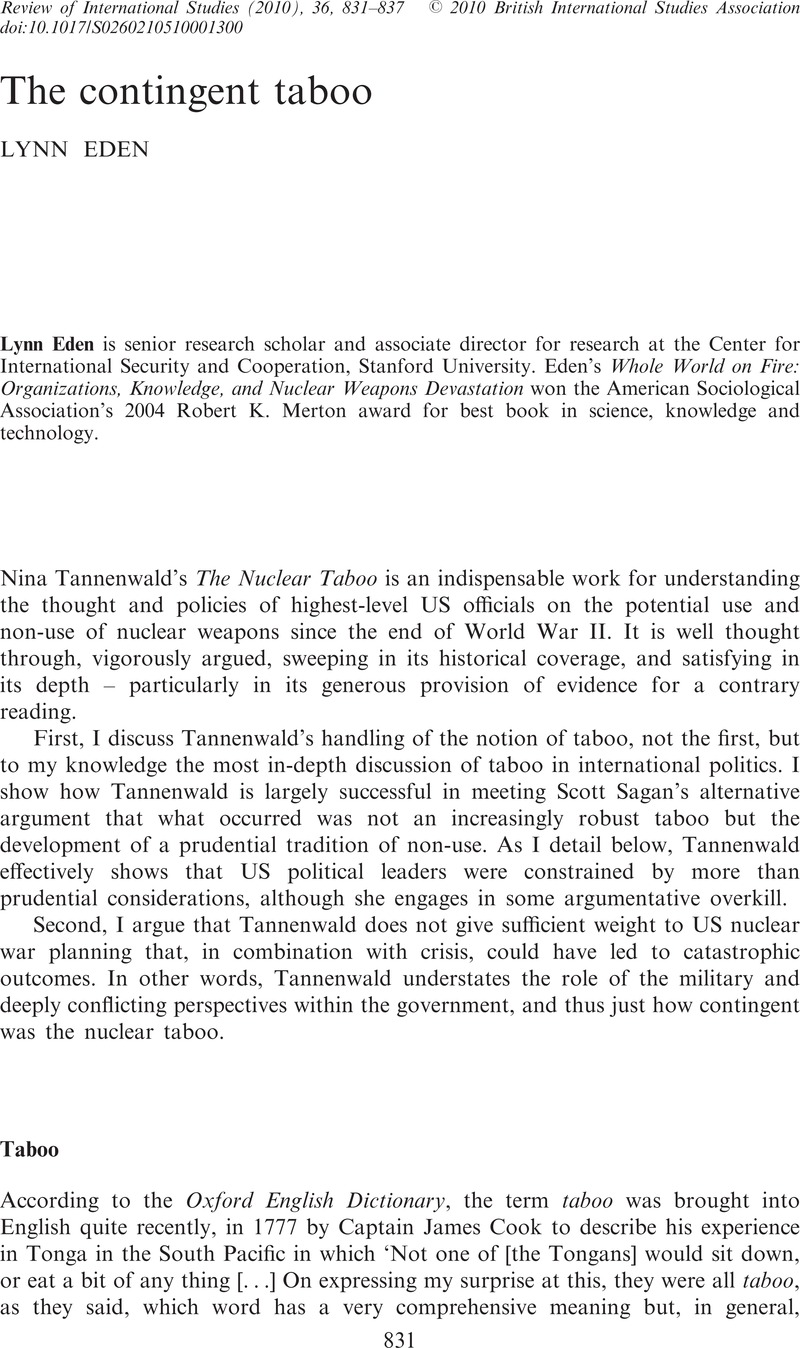Article contents
Abstract

- Type
- Research Article
- Information
- Copyright
- Copyright © British International Studies Association 2010
References
1 Oxford English Dictionary (1989 edition), online, quoting James Cook, Voyages to the Pacific (spelling and grammar somewhat modernised).
2 Tannenwald, Nina, The Nuclear Taboo: The US and the Non-Use of Nuclear Weapons Since 1945 (Cambridge: Cambridge University Press, 2007), pp. 10–11CrossRefGoogle Scholar .
3 Tannenwald, , Nuclear Taboo, pp. 12, 16Google Scholar .
4 National Conference of Catholic Bishops, The Challenge of Peace: God's Promise and Our Response, A Pastoral Letter on War and Peace, 3 May 1983 (Washington, DC: US Catholic Conference, 1983), p. 137Google Scholar .
5 Sagan, Scott D., ‘Realist Perspectives on Ethical Norms and Weapons of Mass Destruction’, in Hashmi, Sohail H. and Lee, Steven P. (eds), Ethics and Weapons of Mass Destruction: Religious and Secular Perspectives (Cambridge: Cambridge University Press, 2004), pp. 73–95CrossRefGoogle Scholar .
6 Tannenwald, , Nuclear Taboo, pp. 144–145, 299Google Scholar .
7 Ibid., pp. 15–6; quotes on p. 16.
8 Ibid., p. 15.
9 Sagan, Scott D., ‘SIOP-62: The Nuclear War Plan Briefing to President Kennedy’, International Security, 12 (1987), p. 35CrossRefGoogle Scholar .
10 On the logic of US nuclear war planning in implicit or explicit historical context, see, in addition to Sagan, ‘SIOP-62’; Rosenberg, David Alan, ‘The Origins of Overkill: Nuclear Weapons and American Strategy, 1945–1960’, International Security, 7 (1983), pp. 3–71CrossRefGoogle Scholar ; Postol, Theodore A., ‘Targeting’, in Carter, Ashton B., Steinbruner, John D., Zraket, Charles Z. (eds), Managing Nuclear Operations (Washington, DC: Brookings Institution, 1987), pp. 373–406Google Scholar ; Steinbruner, John D., ‘Choices and Trade-offs’, in Carter, et al. , Managing Nuclear Operations, pp. 535–554Google Scholar ; Trachtenberg, Marc, ‘A “Wasting Asset”: American Strategy and the Shifting Nuclear Balance, 1949–1954’, International Security, 13 (1988/1989), pp. 5–49CrossRefGoogle Scholar ; Sagan, Scott D., Moving Targets: Nuclear Strategy and National Security (Princeton: Princeton University Press, 1989), pp. 10–57Google Scholar ; Nolan, Janne E., Guardians of the Arsenal: The Politics of Nuclear Strategy (New York: Basic Books, 1989)Google Scholar ; Blair, Bruce G., The Logic of Accidental Nuclear War (Washington, DC: Brookings Institution, 1993)Google Scholar , which is, however, about more than accident; see esp. chap. 3, pp. 38–58; William Burr, ‘“To Have the Only Option That of Killing 80 Million People is the Height of Immorality”, The Nixon Administration, the SIOP, and the Search for Limited Nuclear Options, 1969–1974’, National Security Archive Electronic Briefing Book No. 173 (23 November 2005), {http://www.gwu.edu/~nsarchiv/NSAEBB/NSAEBB173/index.htm}. On consequential but opaque military assumptions, see Eden, Lynn, Whole World on Fire: Organizations, Knowledge, and Nuclear Weapons Devastation (Ithaca: Cornell University Press, 2004)Google Scholar .
11 General Russell E. Dougherty (US) Air Force, retired), interview with Lynn Eden, McLean, Virginia, (30 October 1987).
12 Nolan, Janne E. and Holmes, James R., ‘The bureaucracy of deterrence’, Bulletin of the Atomic Scientists, 64 (March/April 2008), pp. 40–41CrossRefGoogle Scholar .
13 Tannenwald, , Nuclear Taboo, pp. 193–195Google Scholar .
14 Ibid., p. 219.
15 Ibid., pp. 222–4.
16 Ibid, pp. 302–3, 307, 312.
- 7
- Cited by


